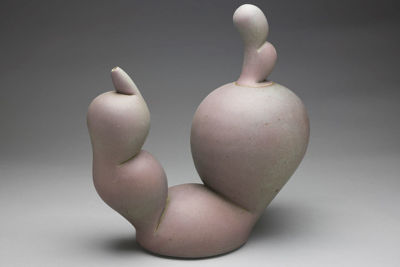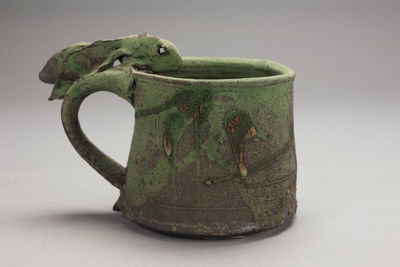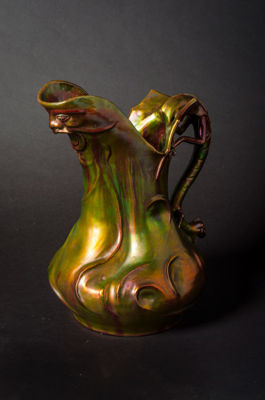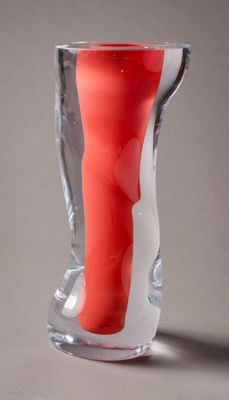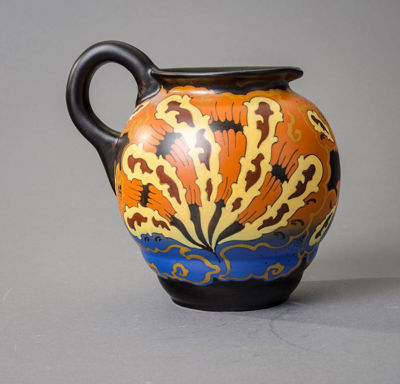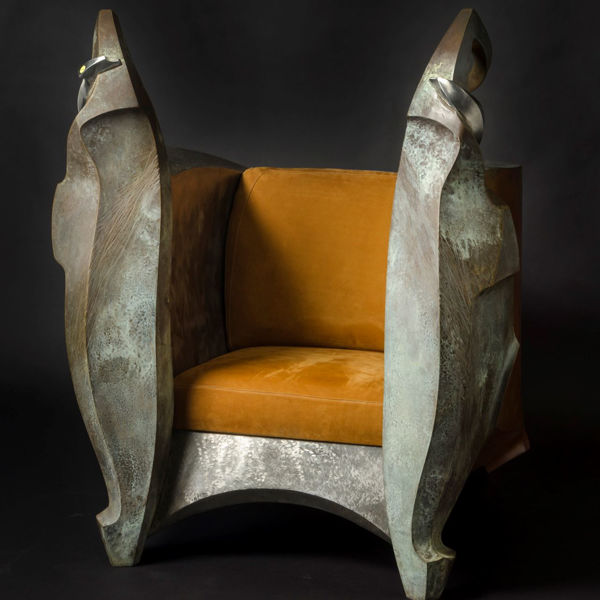Decorative and Design
Title: Purple and Gray Teapot
Gustin works in wild fusions of sculptural and functional aesthetic, allowing clay to perform remarkable and sometimes gravity-defying duties. ‘Purple & Grey Teapot’ transmits biomorphic influence, its elliptical, fatty portions expressive of flesh in architecture and colour. the principles of the teapot are exposed & reinterpreted so as to search out for new definition, and to test Gustin’s aptitude in a practice that he has been developing from a young age in his father’s ceramic tile company.
Title: Queen's Ware Decanter
Wedgwood Queen's Ware Punch Decanter and Stopper, England, c. 1880, the stopper molded with a bust of Punch, the decanter brown transfer printed with scenes of Punch and Toby, impressed mark, ht. 12 1/4 in. Provenance: Property of the Saint Louis Art Museum. Sold to benefit the acquisition fund. Top of Punch's hat restored.
Title: Rabbit Cup
Ken Ferguson (1928-2004) was a ceramicist best known for creating vessels with animal or anthropomorphic qualities included in the form. “Rabbit Cup” subtly alters the dynamics and flairs of a traditional cup with the addition of a rabbit’s head, the motif transforming the curvature of the handle to suggest a larger figurative outline. A dipped green[?] glaze has the object accrue a rough patina and hints at other decorative motifs — the simplicity and elegant coarseness of the cup indicative of Ferguson’s legendarily prolific output, often fashioning a sizeable quantity of work in a single day.
Title: Rare Candlestick
Roycroft items began being produced in the late 19th-century in East Aurora, NY, the workshop and community forming around the entrepreneurial spirit of Elbert Hubbard, his theories around artistic upheaval and a gradual societal unshackling from boundaries imposed in the Victorian era having pushed him to invest in and establish an assortment of manufacturing space for craft works. Of the various forms of production that took place — printing, furniture making, leather working — the results of the metal workshop, with hammered copper in particular, have become highly sought after for their charm and cultivated beauty, the design and fabrication ushering in a stripped back and cleaner approach to form, part-influenced by various member’s exposure to European Secessionist and proto-Modernist movement. Orb and cross mark; Literature: The FRA, March 1916, p. xxiv-b
Title: Rare Pitcher With Dragon
Rare large pitcher with grotesque and dragon Vallauris, France,ca. 1990; Body signed J. Massier Fils Vallauris; 16 3/4" x 14"
Title: Raven in Black Basalt
Raven from the celebrated English ceramic firm, modelled by Ernest Light and completed in black basalt with distinctive glass eyes in the early 20th century. Josiah Wedgwood introduced into production a black stoneware body in 1768. The first trials for Wedgwood's new black body had begun by July 1766, even before the move to Etruria. By September 1767 his experiments were at an advanced stage, ready for production, and less than twelve months later black basalt wares were on the market. He called it ‘Black Basaltes'; we know it as black basalt. Made from reddish-brown clay which burned black in firing, this ceramic body was superior in its appearance to the local 'Egyptian Black' wares produced in the area prior to that date.
Title: Raw Diamonds by Us Espresso Cups
Directors Cut Collection by Menu. Rough on the outside, soft on the inside. Don't let the raw appearance fool you. It hides the smooth inner surface inspired by floral tattoos, rococo patterns and japanese flower motives, a real diamond in the rough - that's the essence of "Raw Diamonds by Us"
Title: Red Hearth Bottle
Influenced by Hans Coper and through him, Liz Fritsch, a new kind of vessel arrived, sometimes described as “Pot as Image” because it combined pictorial devices with actual form, making flattened shapes that seemed full and round but created the depth through playing with perspective. Judy Trim was one of the best proponents of this style.
Title: Redware Teapot and Cover
Mid-18th Century Redware Teapot with cover. The cylindrical body, stylised spout and handle — shaped to resemble bamboo — and glazed black dragon relief over a lighter buff indicate a purveying Chinese influence designed to appeal to the collector.
Title: Regina Pitcher
Gouda is a style of Dutch pottery named after the city of Gouda. Gouda pottery gained worldwide prominence in the early 20th century and remains highly desirable to collectors today. Gouda pottery is diverse and visually distinctive in appearance, typically illustrated with colourful and highly decorated Art Nouveau or Art Deco designs.
Title: Reticulated Vase
Teco, or the Terra Cotta Tile & Ceramic Company, founded by William Day Gates in 1881, were the first major manufacturer of architecturally-focused terra cotta — their practical lines of tile, brick, chimney and urn gradually complemented by a burgeoning set of art pottery that carries similar ideals and methodology. Overall form is presented in a simple, reduced palette of shape, the large bulk designed by Gates or the school of Prairie School Chicago architects following in the wake of Louis Sullivan — including William James Dodd and the eminent Frank Lloyd Wright. The pieces aimed to convey a decorative purpose through the merging and flattening of geometric and organic structures in a naturalistic fashion, and the industrial process of their construction meant an increased affordability. The micro-crystalline green glaze has a wispy, crisp silvered tonality, its unique characteristic developed by Gates over 13 years, and is generally applied on shades of black overglaze to add understated depth.

